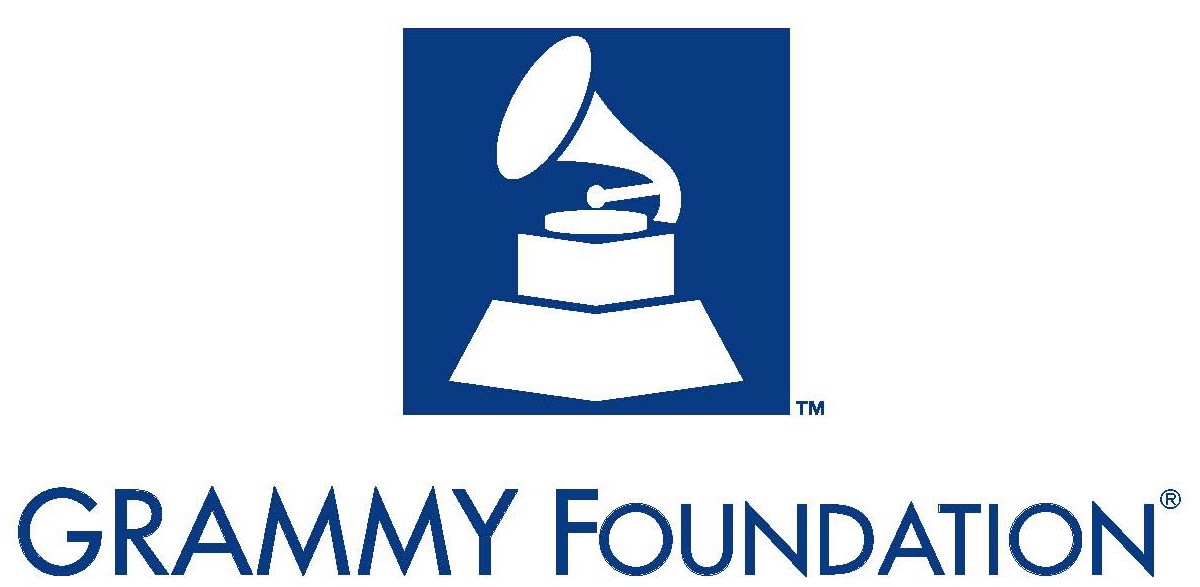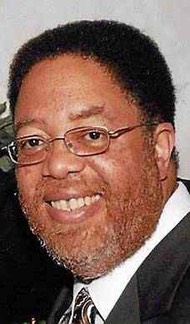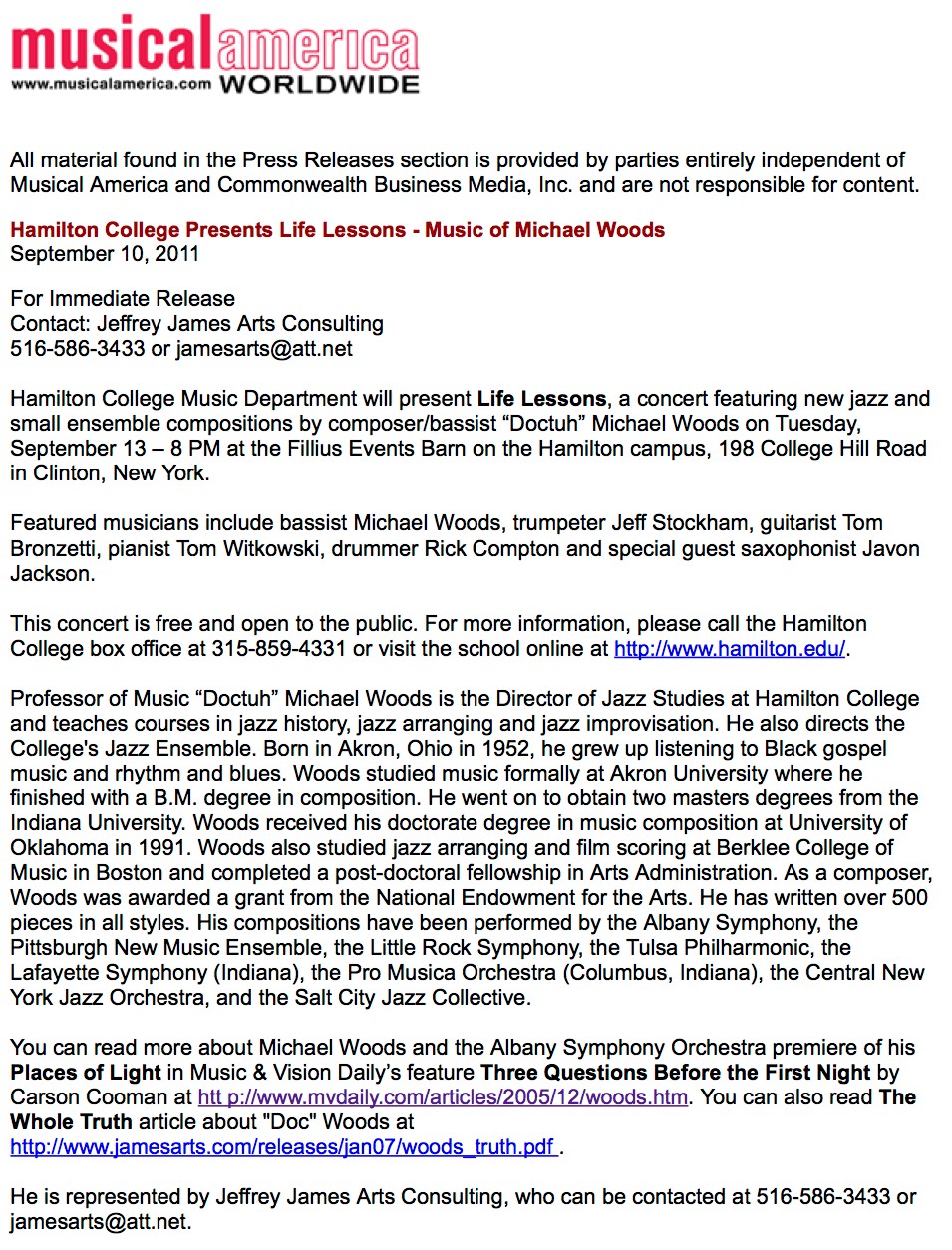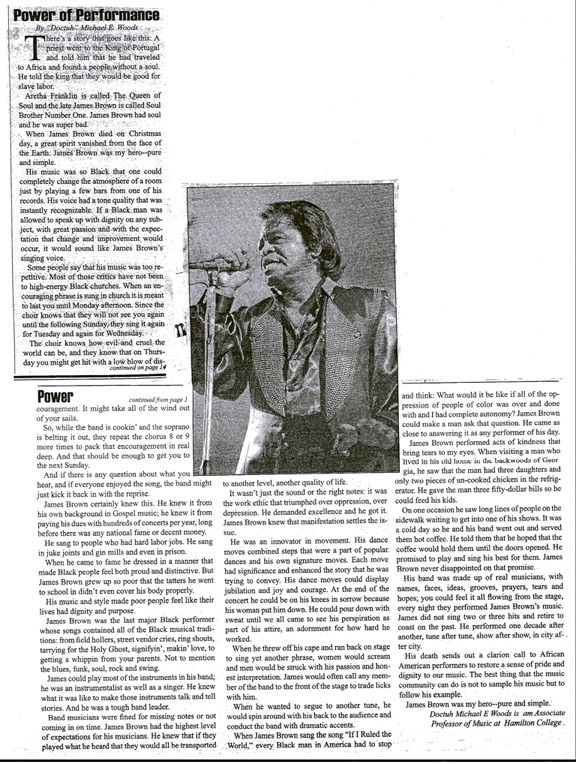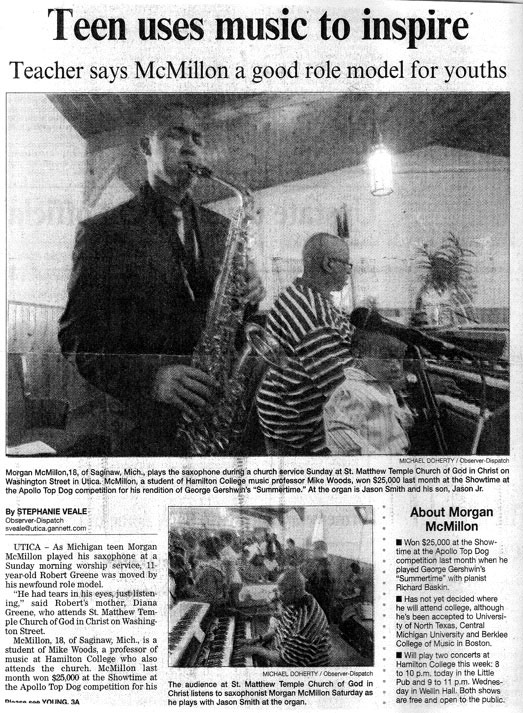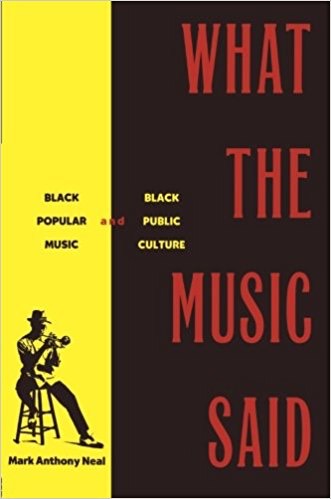'Life Lessons – Music of Michael Woods' Sept. 13, Clinton, New York

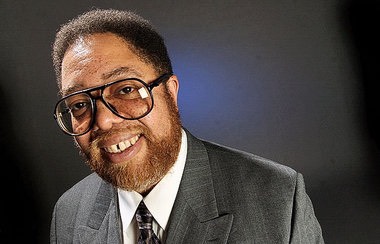
Jeffrey James Arts Consulting Release:
“Hamilton College Music Department will present Life Lessons, a concert featuring new jazz and small ensemble compositions by composer/bassist 'Doctuh' Michael Woods on Tuesday, September 13 – 8 PM at the Fillius Events Barn on the Hamilton campus, 198 College Hill Road in Clinton, New York. Featured musicians include bassist Michael Woods, trumpeter Jeff Stockham, guitarist Tom Bronzetti, pianist Tom Witkowski, drummer Rick Compton and special guest saxophonist Javon Jackson.
“This concert is free and open to the public. For more information, please call the Hamilton College box office at 315-859-4331 or visit the school online at http://www.hamilton.edu/.
“Professor of Music 'Doctuh' Michael Woods is the Director of Jazz Studies at Hamilton College and teaches courses in jazz history, jazz arranging and jazz improvisation. He also directs the College's Jazz Ensemble. Born in Akron, Ohio in 1952, he grew up listening to Black gospel music and rhythm and blues.
“Woods studied music formally at Akron University where he finished with a B.M. degree in composition. He went on to obtain two masters degrees from the Indiana University. Woods received his doctorate degree in music composition at University of Oklahoma in 1991. Woods also studied jazz arranging and film scoring at Berklee College of Music in Boston and completed a post-doctoral fellowship in Arts Administration.
“As a composer, Woods was awarded a grant from the National Endowment for the Arts. He has written over 500 pieces in all styles. His compositions have been performed by the Albany Symphony, the Pittsburgh New Music Ensemble, the Little Rock Symphony, the Tulsa Philharmonic, the Lafayette Symphony (Indiana), the Pro Musica Orchestra (Columbus, Indiana), the Central New York Jazz Orchestra, and the Salt City Jazz Collective.”
Awards
Hamilton College music professor a GRAMMY Music Educator Award quarterfinalist

Clinton >> Hamilton College professor of music, “Doc” Michael Woods, has been recognized for excellence in music education, and nominated for the 2016 GRAMMY Music Educator Award.
Woods, who has four degrees in music including a DMA from The University of Oklahoma, has taught music at the college level for 35 years. He joined Hamilton College in 1993, was tenured in 1998, and has since been promoted to the rank of professor.
More than 4500 nominations from 50 states were received by The Recording Academy and The Grammy Foundation; Woods, who was nominated by a former student, was selected as a quarterfinalist.
Woods volunteers his services throughout the community and mentors, teaches and encourages excellence in others, in and outside of the classroom. “I am humbled to have been nominated, and will continue to create new ways to support, engage, and enhance the interests and talents of my students, and inspire others to achieve their goals,” he said.
The Music Educator Award was established to recognize current educators (kindergarten through college, public and private schools) who have made a significant and lasting contribution to the field of music education and who demonstrate a commitment to the broader cause of maintaining music education in the schools. A joint partnership and presentation of The Recording Academy and the GRAMMY Foundation, this special award will be presented at the Special Merit Awards Ceremony & Nominees Reception (honoring recipients of the Lifetime Achievement Award, Trustees Award and Technical GRAMMY Award) during GRAMMY Week 2016.
Each year, one recipient will be selected from finalists, and will be recognized for his/her remarkable impact on students’ lives. The winner will be flown to host city of the GRAMMY Awards to accept the award, attend the GRAMMY Awards ceremony, and receive a $10,000 honorarium. The nine other finalists will each receive a $1,000 honorarium, and the schools of all 10 finalists will receive matching grants. The honorariums and grants provided to the finalists and schools are made possible by the generosity and support of the GRAMMY Foundation’s Education Champions: Converse, Disney Performing Arts, Ford Motor Company Fund, and Journeys.
BlackGrooves album review - "UhThuh Planets"

Title: Uhthuh Planets
Artist: “Doctuh” Michael Woods
Label: 4Tay Inc
Formats: CD, MP3
Release Date: July 7, 2014
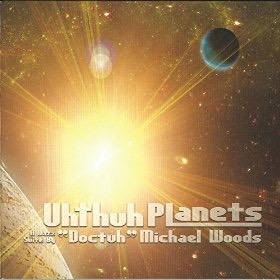
This release by “Doctuh” Michael Woods has been out for some time, but has recently come to this reviewer’s attention. Woods is the director of Jazz Studies at Hamilton College in Clinton New York, and is a versatile and highly credentialed composer, holding a B.M. in Composition from Akron University, two master’s degrees from Indiana University, and a doctorate in music composition from the University of Oklahoma. He has written everything from symphonic works to compositions for small jazz ensembles.
Woods describes Uhthuh Planets as “a treatise on ‘Funk,’” despite few explicit references to the popular music genre by that name in the music included on this album, which is more reminiscent of the contemporary jazz suite that the album’s subtitle (“A Jazz Suite”) references. Uhthuh Planets features excellent musicianship, with Woods and his sidemen playing the album’s arrangements sensitively (listen to Tom Witkowski’s interpretation of “Piano I.Q.,” a piece that is supposed to sound like an alien interpretation of Art Tatum) and taking some strong solos, (hear Wood’s electric bass solo on “I Need Options” and guitarist Tom Bronzetti’s lyrical improvisation on “Enoch”).
The record does include some of the programmatic iconography that interstellar groups like Parliament Funkadelic have utilized in liner notes detailing outer space scenes, but the strange sonic textures that would characterize more ‘far out’ musicians like Sun Ra that many may expect as self-conscious sonic references to other interstellar genres are largely absent from this suite.
While the music on Uhthuh Planets pulls more from standard contemporary jazz composing and arranging than some of the weirdness that the album’s artwork and programmatic notes may suggest, this album is a well-composed and played jazz suite, and is definitely worth a few listens for those eager to hear extended compositions and compelling improvisations.
Reviewed by Matthew Alley
Diversity goes to head of class at Hamilton

In a Utopian society, colleges wouldn't need to enforce a "diversity requirement," according to Michael "Doc" Woods, a professor at Hamilton College.
By Alissa Scott
CLINTON — In a Utopian society, colleges wouldn't need to enforce a "diversity requirement," said Michael "Doc" Woods, a professor at Hamilton College.
"But until we get there, it's necessary," Woods said, speaking of a new requirement Hamilton began this fall. "College is the last dropping-off place where a young person has a chance to learn long-lasting career skills and have those skills connected to an ideology of how to treat people right in the work place."
Officials at Hamilton announced in May they would institute a diversity requirement for all students to begin fall 2017.
Similar to many colleges across the country, it will be mandatory for Hamilton students to pass a course or combination of courses that examine "structural and institutional hierarchies based on one or more of the social categories of race, class, gender, ethnicity, nationality, religion, sexuality, age, and abilities/disabilities" to complete their degree.
What's next: Proposals for implementation of the requirement in the concentrations are due from departments and programs in February 2017. Implementation for 2017-18 with review by CAP in 2021-22.
"What's different about Hamilton's requirement is that each department will design the requirement for their majors," said Karen Brewer, a chemistry professor and chairwoman of the subcommittee that reviewed the classes. "And in that way, they can make it relevant and meaningful to those students for their future goals in the department and their majors, as well as their careers."
For Woods' classes, that's easy. He teaches music at the liberal arts school and incorporates black culture into his jazz classes. But his department as a whole, he said, is very diverse, too. There are people of different races and sexual orientation.
"I'm an African-American," he said, "so what happens in my classes has a lot to do with African-American life."
Brewer said for other students, classes might look at the history or philosophy of the discipline.
"Questions that might be asked might include what is the scientific and social definition — distinction of race, for example," she said. "Is our science gender and race-blind? Who benefits from medical research and drug trials? So we can look at those from that perspective, and that's where the students are most interested."
Henry Shuldiner, a sophomore at Hamilton , spent the summer interning at The Chronicle of Higher Education and wrote a commentary piece about the change.
"We modern-day liberal arts students are equipped with a variety of skills and experiences within our concentrations or majors," he wrote. "We have the potential to connect different ideas so that they can be applied in different contexts. ... I believe it is Hamilton's job to teach its students about the blend of all the beautifully unique groups of people and cultures in our state, our country, our world. This new requirement is a welcome step toward that goal."
He noted that in the fall of 2015, an anonymous student group called The Movement sent Hamilton's president a list of demands, many of them touching on the lack of diversity on campus.
"Hamilton needs a curriculum that values the importance of understanding issues revolving around systemic power dynamics and inequities," the demand reads. "We demand the creation of diversity intensive courses."
Utica College instituted a diversity requirement several decades ago, said John Johnsen, provost and vice president for academic affairs.
"They must take at least one course that deals largely with issues related to diversity," Johnsen said. "They all happen to be social science courses, so typically they're history, anthropology, sociology. We think it's an essential part of their learning, of being a citizen of the country in our world."
DOC WOODS ON BEYONCE’S NEW VIDEO

February is Black History Month and, thanks to a number of developments in the Beyoncé world, pop culture has been flooded with new debates and discussions about race.
Some background if you’re not caught up: Beyoncé—aka the most Grammy-nominated female artist ever—put on a halftime performance at Super Bowl 50, which contained references to the Black Panther Party. The day before, she released a video called “Formation,” which contained references to Hurricane Katrina, the Black Lives Matter movement and southern black femininity.
In an attempt to sort through all the media attention and to get a handle on the real value of “Formation," we reached out to professors within Africana studies programs and staff members who regularly work with minority students at area colleges.
From those we heard back from, the overall reaction to Beyoncé’s video was positive.
People appreciated “the power and sense of self” that the pop star projects and the conversation she was starting. Some worried, though, about the outcome of the “uninformed criticism” that would likely come as a result.
Michael “Doc” Woods, a longtime professor of music at Hamilton College, offered the most insightful response. Woods, it’s worth noting, is black himself, and he had not seen “Formation” until we sent it to him. Here are some of the things he had to say.
On the song's beat
“That, to me, is rocking.”
On the use of explicit language
“I don’t like to hear a woman of that beauty use that kind of language, but to tell you the truth, there isn’t some pleasant, cute way of saying [certain realities]. … Some people can’t control the anger and there are curse words. The reason those curse words are in there is [artists] are cursing the poison that’s in our society that won’t allow them to be a complete human being.”
On the shock factor
“Sometimes, in order to get people’s attention, you have to do the opposite of what’s expected.”
On the Black Lives Matter references
“That is nothing new. It’s just a new statement to an old problem. Black entertainers are trying to say, ‘Oh yes we do count. We have always counted.’ Here’s what people don’t understand: If you look at the way black America has traditionally been treated by white America, black Americans and their accomplishments have been ignored as much as possible, as if our lives don’t matter.”
On the anger and aggression Beyoncé is expressing
“For black people to be treated so badly and then for people to expect the art to not express anger, that’s an unrealistic expectation. … What she’s doing in that video is no different than Tupac Shakur writing ‘thug life’ across his stomach. He wanted to be a classical poet. Their hearts are filled with pain. It’s painful to have your life defined by sweeping generalizations.”
On the use of children in the video
“She shows three little black girls like she must have looked like 25 years ago, and she says, ‘I’m a star.’ What she’s trying to say with that is, ‘Don’t allow society to tell you who you are because you don’t fit a certain protocol.’”
On black popular music today
“There is a weird, macabre mixture of protest and anger and deep, deep distrust. If you listen to any black music, from 1900 until 2016, you will hear in it a cry. There’s a cry inside the music.”
On Beyoncé in general
“From my perspective when I see [the video], as a person of color, she’s one of my champions. I would love to play on a stage of that magnitude. I don’t think she’d be saying these things unless she thought it was necessary.”
Doc Woods Presents "Funk Republic"
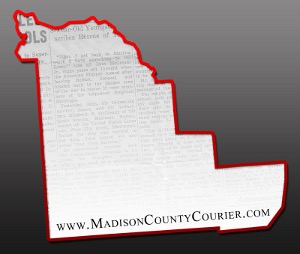
(Clinton, NY – Sept. 2014) Hamilton College professor of music, “Doc” Michael Woods is set to present his 21st Annual Jazz Kick-off Concert on Wednesday, Sept.10 at 7:30 p.m.
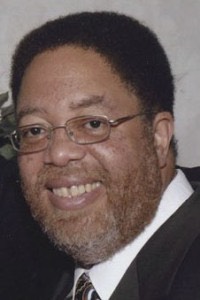
“Doc” Woods who has written more than 700 music works in all genres, has a passion for introducing new music to audiences that provide sonic solutions to what may be occurring culturally, socially or spiritually in our community or society.
This year, Woods invites everyone to visit “Funk Republic” which is not a gated community. All are welcome to visit, or reside in the community and partake of and flourish in the funky grooves, intricate rhythms, syncopated beats, and twists and turns of each piece of this musical suite.
Woods will be joined on stage by a 6-piece ensemble comprised of CNY musicians and Guest Artist Jakubu Griffin of Las Vegas, Nev. Griffin, a drummer and percussion specialist, has been featured on several prior Kick-off concerts.
“Funk Republic” will be presented at Wellin Hall in the Schambach Center at Hamilton College. The event is open to the public, and the first 500 in attendance, will be admitted at no charge.
eJazz Lines

“Doctuh" Michael Woods has written more than 700 compositions in styles that include choral, orchestral and chamber works, and jazz combo and big-band charts. His works have been performed by the Albany Symphony, the North Arkansas Symphony Orchestra, the Central New York Jazz Orchestra, the Tulsa Philharmonic, the Salt City Jazz Collective and the central New York Jazz Orchestra. Woods is director and bassist for the Zoe Jazz Band, and bassist for the Omniverse jazz ensemble. Both groups perform his compositions. He majored in composition and minored in string bass at Indiana University (M.M.), and the University of Oklahoma (D.M.A.) and was the first African-American to receive a doctorate in composition from Oklahoma.
Faculty concert opens fall series at Hamilton College Friday

CLINTON — Hamilton College Department of Music’s semester of concerts begins with a Fall Faculty Concert Friday.
The department is set to present “an exciting semester of faculty and student events” in Wellin Hall, Schambach Center for Music and the Performing Arts, department officials said.
All performances are free of charge and begin at 7:30 p.m., unless otherwise noted. Seating for all events is general admission.
Friday, Department of Music faculty musicians are featured in a recital for voice, piano, brass, strings, and more.
The annual Jazz Kick-Off Concert with “Doc” Woods follows on Wednesday, Sept. 9. Guest artist Jakubu Griffin, drums, performs with Woods, bass and composition; Jeff Stockham, trumpet; Tom Witkowski, piano; Joe Handy, guitar; and Angelo Candela, trombone, in an evening of all new charts.
Jon Fredric West, heldentenor, and Kenneth Bowen, piano, perform “A Gloucestershire Evening with Ralph Vaughan Williams” on Friday, Sept. 25. The recital features “Songs of Travel,” a song cycle of nine songs with poems selected from the Robert Louis Stevenson collection of the same name.
Faculty Recitals continue in October with Mescolare on Saturday, Oct. 10. Comprised of Rick Balestra guitar, Barry Blumenthal, keyboards, Chris Colabello, bass, and Mike Cortese, drums, Mescolare combines jazz, Brazilian, funk, and African popular music for a truly unique sound.
Hamilton College’s Family Weekend performances round out October. The Hamilton College Choir and Department of Dance and Movement Studies share the stage for a performance of choral song and original choreography from Hamilton College faculty performed by current students on Friday, Oct . 23 at 7:30 and again on Saturday, Oct. 24 at 1:30 p.m. The Hamilton College Orchestra and Jazz Ensemble perform in a dual program on Saturday at 7:30 p.m. Heather Buchman conducts the orchestra in Mozart’s Symphony No. 36, K. 425 (Linz). While “Doc” Woods leads the jazz ensemble.
The Jazz Combo plays a relaxed concert in Café Opus featuring charts for small ensemble and soloists on Tuesday, Nov. 10 at 9 p.m.
Tenor Jon English and pianist Sar-Shalom Strong present a complete performance of Franz Schubert’s Die Winterreise (The Winter Journey) on Sunday, Nov. 15 at 3 p.m. This extensive song cycle presents an angst-filled picture of youthful love lost, and is considered to be among Schubert’s best works.
Hamilton College and Community Masterworks Chorale with Symphoria present their winter concert on Tuesday, Dec. 1. For the first time in 10 years, the Masterworks Chorale will present George Frideric Handel’s immortal oratorio Messiah. Since its premier performance in Dublin in 1742, this iconic work has never fallen from the concert repertoire and continues to engage audiences around the world. Tickets are $10 adult and $8 for senior citizens and students.
Under the direction of Heather Buchman, the Hamilton College Orchestra performs a winter concert of Mozart’s Symphony No. 36 and Dvorák’s Czech Suite on Friday, Dec. 4.
The Student Soloists Concert is Saturday, Dec. 5. This event is student recital for voice, winds, strings, brass, piano, and more.
The Hamilton College Jazz Ensemble turns Café Opus into a jazz club for its final concert of the semester in Café Opus on Monday, Dec 7. “Doc” Woods leads the ensemble in new charts and jazz standards.
Rounding out the semester is Tchaikovsky’s Nutcracker Ballet on Friday, Dec. 11 at 7:30 p.m.
Saturday Dec. 12 at 2 p.m. and 7:30 p.m. and Sunday, Dec. 13 at 2 p.m. The Hamilton College Department of Music and Utica Dance co-produce Tchaikovsky’s timeless classic ballet, Nutcracker. Members of the Hamilton College Orchestra and Symphoria, conducted by Heather Buchman, provide musical accompaniment for the evening performances. In addition, Utica Dance will offer two matinee performances with recorded music. Tickets and information at www.uticadance.com.
For more information, call the box office at 859-4331 or visit www.hamiltonpa.org.
Five Black Scholars Are Taking on New Assignments
Jose Cossa was appointed a senior lecturer in international and domestic policy in the department of leadership, policy, and organizations of Peabody College at Vanderbilt University in Nashville, Tennessee. He has been serving as a visiting associate professor at the American University of Cairo. Dr. Cossa is the author of Power, Politics, and Higher Education: International Regimes, Local Governments, and Educational Autonomy (Cambria Press, 2008).
Dr. Cossa holds a master’s degree from the Cape Theological Seminary in South Africa and a Ph.D. in cultural and educational policy studies from Loyola University of Chicago.
Michael Woods was named the Leonard C. Ferguson Professor of Music at Hamilton College in Clinton, New York. He has written over 700 musical compositions.
Professor Woods holds a master’s degree in composition from Indiana University and was the first African American to earn a doctorate in music composition from the University of Oklahoma.
Derek Conrad Murray, an associate professor in the history of art and visual culture department at the University of California, Santa Cruz, has been appointed to the editorial board of Art Journal. The publication is a peer-reviewed journal published by the College Art Association.
Dr. Murray is the author of Queering Post-Black Art: Artists Transforming African American Identity After Civil Rights (I.B. Tauris, 2015). He holds a master’s degree and a Ph.D. in the history of art from Cornell University.
Dean E. Robinson was appointed the Terrance Murray Commonwealth Honors College Professor at the University of Massachusetts at Amherst. He had been serving as an associate professor of political science at the university.
Professor Robinson is the author of Black Nationalism in American Politics and Thought (Cambridge University Press, 2001). He holds a Ph.D. from Yale University.
Michael Bradford was appointed chair of the department of dramatic arts at the University of Connecticut. He will also serve as artistic director of the Connecticut Repertory Theatre. Professor Bradford has served on the faculty at the university since 2001.
Professor Bradford holds a master of fine arts degree in playwriting from Brooklyn College of the City University of New York.
Hamilton College Presents Music of Michael Woods on September 12

Hamilton College will present a concert featuring small jazz ensemble music by “Doctuh” Michael Woods on Wednesday, September 12, 9 PM at the Filius Events Barn on the Hamilton campus, 198 College Hill Road in Clinton, New York.
Bassist “Doctuh” Michael Woods will join trumpeter Jeff Stockham, vocalist Ronnie Leigh and others for a program of his original compositions for small jazz ensemble.
This concert is free and open to the public. For more information, please call the Hamilton College box office at 315-859-4331 or visit the school online at http://www.hamilton.edu/.
Associate Professor of Music “Doctuh” Michael Woods is the Director of Jazz Studies at Hamilton College. Born in Akron, Ohio in 1952, he grew up listening to Black gospel music and rhythm and blues. Woods studied music formally at Akron University where he finished with a B.M. degree in composition. He went on to obtain two masters degrees from the Indiana University. Woods received his doctorate degree in music composition at University of Oklahoma in 1991. Woods also studied jazz arranging and film scoring at Berklee College of Music in Boston and completed a post-doctoral fellowship in Arts Administration. As a composer, Woods was awarded a grant from the National Endowment for the Arts. He has written over 500 pieces in all styles. His compositions have been performed by the Albany Symphony, the Pittsburgh New Music Ensemble, the Little Rock Symphony, the Tulsa Philharmonic, the Lafayette Symphony (Indiana), the Pro Musica Orchestra (Columbus, Indiana), the Central New York Jazz Orchestra, and the Salt City Jazz Collective.
You can read more about Michael Woods and the Albany Symphony Orchestra premiere of his Places of Light in Music & Vision Daily’s feature Three Questions Before the First Night by Carson Cooman at http://www.mvdaily.com/articles/2005/12/woods.htm. You can also read a new The Whole Truth article About “Doc” Woods at http://www.jamesarts.com/releases/jan07/woods_truth.pdf and his Places of Light blog at http://www.sequenza21.com/places.html.
Hamilton College professor creating ‘funky’ album to empower black youth

By Alissa Scott / ascott@uticaod.com
There aren’t different types of music in Michael Woods’ eyes. There’s just music.
That idea has been on his mind since he started creating a new album he hopes will empower black youth called “A Bowl of Embers.”
“My concept is to combine all manners of harmonic languages in combinations that don’t’ seem like they would be compatible,” said “Doctuh” Woods, a professor of music at Hamilton College. “I start out with a hard bob swing feel that turns into a classical counterpoint. These genres were never meant to be as separated as we make them. There’s only one genre – that’s music.”
And he carries that idea over to people. He says people were never meant to be as separated as they are either.
“There is no such thing as black and white,” Woods said. “It doesn’t exist. It was invented for the purpose of identification and for the purpose of manipulation.”
The album, which will be available online in three weeks, is comprised of nine related tracks that feature instrumental jazz. Woods got “a bunch of superstar players up in Syracuse on the horns, strings and guitar” to play with him.
“Living in this society as a person of color, I’ve lived in this area for the last 23 years,” he said. “When I turn on the news every night, I see the most horrific things happening across the nation and around the world, particularly to people of color.”
So he made up his mind. Woods said he decided he wasn’t going to respond with anger, because there was already too much of that. He was going to respond with music.
“I decided to respond by writing music so beautiful, so funky, so hip, so informed that it makes people happy,” he said. “Happiness is a safeguard against debauchery. Happy people make good decisions.”
The album’s title, “A Bowl of Embers,” is reflective of a concept Woods created when making the album.
“You call it an ember because it’s not dead yet,” Woods said. It still has a little heat in it. If you blow air on the coals, fire will catch back again. When I did this album, I imagined God holding the Earth in the palm of his hand and seeing him gently blowing kindness back into the hearts of mankind.”
He said he sees his job as a composer similar to that of an old sea captain. Years ago, when ships used to sail the ocean, they would bring a compass, he said. But when the sun went down, they’d become disoriented.
So people started mapping the stars.
“Instead of looking up at the stars, I listen up at the stars,” Woods said. “I write a chart and I get my crazy buddies to play it and I tell people, ‘Here’s where we’re going in the future. Here’s what the future sounds like. If you want to hear hope, here’s what it sounds like.’”
Jazz kick-off at college Wednesday
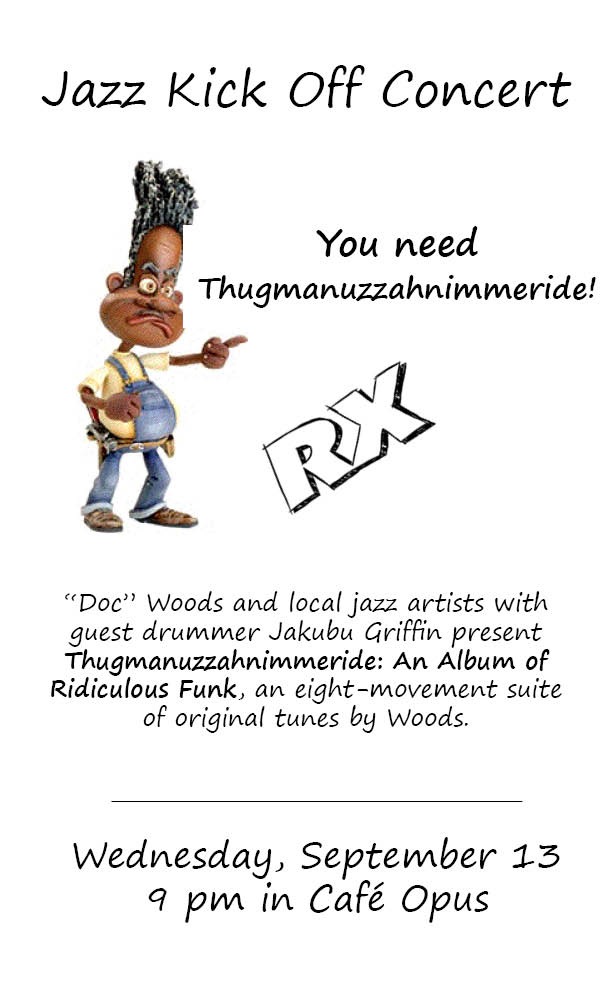
CLINTON — Hamilton College professor of music, “Doc” Michael Woods presents his 24th Annual Jazz Kick-off Concert on Wednesday, Sept. 13, at 9 p.m.
Woods will present a suite of 8 new pieces at Wellin Hall in the Schambach Center at Hamilton College. The concert is free.
Woods, who has written over 700 music works in all genres. “With the myriad of complex issues that we are facing as a nation, music is a common denominator that brings us together,” Woods said in a statement. “This new music suite of 8 pieces, (...) ‘Thugmanuzzahinemmeride’ was composed to provide a remedy for what is ailing us. Those in attendance will leave feeling hopeful about our future.”
Woods will be joined on stage by “world-renown” drummer and percussionist Jakubu Griffin of Las Vegas, Nev., who has been featured on several prior Kick-off concerts.
NAfME Members Make Up the Lion’s Share of 2016 GRAMMY Music Educator Award Quarterfinalists

The GRAMMY Foundation has announced 213 quarter-finalists for the 2016 GRAMMY Music Educator Award™ , and of that number, 122 are members of the National Association for Music Education (NAfME). In all, more than 4,500 initial nominations were submitted from each of the 50 states. From elementary general music teachers to band directors, choral conductors, string teachers, and college professors, NAfME congratulates these talented, dedicated music teachers.
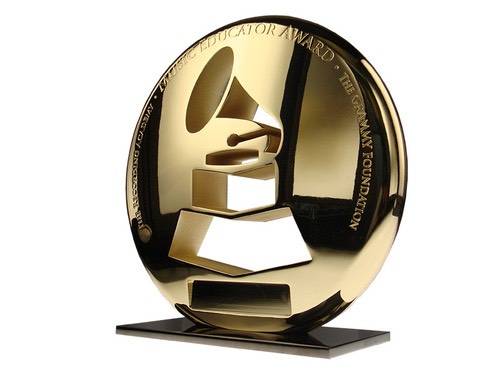
The GRAMMY Music Educator Award was established to recognize current educators (kindergarten through college, public and private schools) who have made a significant and lasting contribution to the field of music education, and who demonstrate a commitment to the broader cause of maintaining music education in the schools.
A joint partnership and presentation of The Recording Academy and the GRAMMY Foundation, this special award will be presented at the Special Merit Awards Ceremony & Nominees Reception (honoring recipients of the Lifetime Achievement Award, Trustees Award and Technical GRAMMY® Award) during 2016 GRAMMY Week.
The 2016 GRAMMY Music Educator Quarter-Finalists (NAfME members indicated with an *) are:
Kenny Sack, Mary Kay McMillin School, Berkeley Heights, N.J.
Susan Schiffman, Manchester Elementary Middle School, Manchester, Vt.
Kyle Schoeller, Northside Elementary, Rogers, Ark.
*Jacob Seymour Lancaster Middle School Lancaster, N.Y.
Chaz Shipman, Freeport Area Junior High School, Sarver, Pa.
Paula Simmons, Elwood Junior -Senior High School, Elwood, Ind.
*Lisa Simone, Hooper Avenue Elementary, Toms River, N.J.
*Joseph Sitler, Brentwood High School, Brentwood, N.Y.
Teresa Slade, Hempstead High School, Dubuque, Iowa
Rachel Slotnick, Franklin Academy, Boynton Beach, Fla.
Kelsey Smith, Mattawan Middle School, Mattawan, Mich.
Siema Swartzel, Arnold Memorial Elementary School, Cleveland, Tenn.
*Bill Swick, Las Vegas Academy of the Arts, Las Vegas, Nev.
*Eric Swihart, Montera Middle School, Oakland Calif.
*Brayer Teague, Downers Grove North High School, Downers Grove, Ill.
*Gregory Thomas, Albemarle High School, Charlottesville, Va.
Tom Thomas, Mason County Central High School, Scottville, Mich.
*Julie Trent, Combs High School, San Tan Valley, Ariz.
*Barry Trobaugh, Munford High School Munford, Tenn.
Carol Turner, Krum High School, Krum, Texas
Kelly Winovich, Northgate Middle/Senior High School, Pittsburgh Pa.
Elijah Wirth, Peabody Preparatory, Baltimore, Md.
*Marcus Wolfe, Valley Christian Conservatory of the Arts, San Jose, Calif.
Michael Woods, Hamilton College, Utica N.Y.
Newstalk - Sun. April 9 with Doc Woods - Jazz Musicican
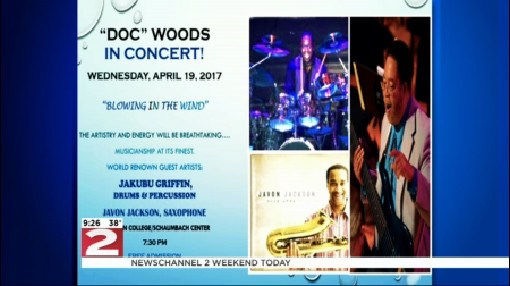
Utica, NY -- Our Newstalk guest this morning was jazz musician Doc Woods in to talk about some upcoming concerts.
Poetry & Jazz
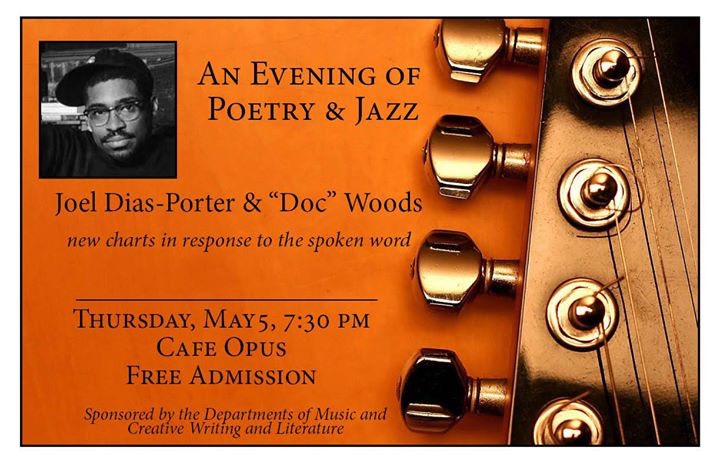
The Departments of Music and Literature and Creative Writing join forces to create a unique evening of poetry and music on Thursday, May 5 at 7:30 pm in Café Opus on the Hamilton College Campus.
Poet Joel Dias-Porter will read original work and a jazz quartet, led by “Doc” Woods, plays brand new charts written by Woods in response to the spoken word. Dias-Porter’s poetry engages the act of improvisation through explorations of intimacy, jazz music, and family heritage
This event is free and open to the public. Light refreshments will be served. For more information, call the box office at 859-4331 or visit www.hamiltonpa.org.
Q&A: Michael ‘Doc’ Woods - Hamilton College Professor Michael “Doc” Woods talks about “Sonic Photos” and his creative process

By CASSAUNDRA BABER
Local jazz musician and professor of music at Hamilton College Michael “Doc” Woods will perform a free concert, “Sonic Photo” at 8 p.m. Monday, Sept. 13, at Hamilton College in the Fillius Events Barn.
We caught up with Woods and asked about his newest work and what inspires him.
Question: You’re always creating, always moving musically. Where do you get your energy, inspiration? Is there anything that doesn’t inspire you?
Answer: The only things that I find un-inspiring are evil, cruelty and poverty. And even then I am compelled to work against those things with great energy.
Q: Talk about the significance of the title Sonic Photo:
A: You usually see a picture and hear a sound. But I love to mix idioms so much so that the very title of the concert begins to get you “out of the box” even before the first beat. A photo is a still shot of something that the photographer found interesting, but what if there were so many subjective elements involved that a snapshot could not tell the whole story. The music then becomes a (lengthier) essay.
Q: One of your new songs is titled “Crude Blues.” Is it about the Gulf oil spill? Talk about that.
A: I love double entendres. The word “crude” can mean raw and lacking in refinement. Of course crude is a type of oil. The oil does not have the blues, but it is sure giving the water the blues. The water does not have a personality, but if it did it would be blue for sure. I like to create titles that cause the listener to feel something from a fresh view point. How would you feel if you were the water?
Q: What specifically inspired this new batch of work?
A: There are four reasons for my latest set of jazz charts. Here they are and not in any specific order. My degrees have been in composition and I go out of my way to stay active in that area. I consider these concerts as a part of my civic duty. God gave me a gift, and if I want Him to constantly provide me with new opportunities I have to do my part by using that gift. I love to make people happy. I have always felt that one can think and react better when they are happy. Hearing a brand new work convinces an audience that a finished product came from a realm of inexhaustible supply. I am also trying to write the next chapter of my own life. I would love to contribute something of dignity to the musical fabric of the United States. I do not know if one of my pieces written 10 years ago will do that, or one that has not been scored out yet. Therefore, I have to write as if the very next one is the gem.
Q: How are you hoping to influence or touch the audience with this new batch of music?
A: My goal in reaching an audience is to cause an interpersonal level of insight to take place between the title, the themes and the great soloists when a new work is played. I want people to say: “I heard that first at Hamilton College back in 2010.”
Q: What’s on your musical radar? What can we expect next from you?
A: I am sketching out some themes for a new orchestral score for Heather Buchman (Hamilton associate professor of music and director of college orchestra and chamber music) to conduct. I am also working on a piece for five instruments for the Syracuse New Music Society. My overall goal is to capture the sound of a nation. If you want to know what America sounded like in the ’40s, you could listen to Duke Ellington and Count Basie. In the ’50s, the sound was rock n roll; in the ’60s, James Brown provided not just the individual voice of two great R&B artists, but the very voice of African- American people as a whole. I want to be one of the voices that America can be proud to say represented wit and humor and craft for several decades. A hint at the new harmonic language that I am employing at this time can be found in a selection called “The Visceral Touch.” This tune will be performed on Monday night.
Q: Concert date and time and place:
A: The concert is at 8 p.m. tonight at Hamilton College in the Fillius Events Barn. The concert is free.
Syracuse Salt City Collective Jazz Band premieres “Sonic Science” at Hamilton College

The community is invited to join Hamilton College professor of music, “Doc” Woods and Special Guests: The Syracuse Salt City Collective Jazz Band, as they premiere “Sonic Science” a suite of new music all written by Woods.
“Doc” has been in his laboratory perfecting new sounds and they are now ready for your listening pleasure. The concert begins at 7:30 p.m. Sept. 14, 2016, at Hamilton College in the Wellin Auditorium.
Three Questions before the first night…...

Composer and jazz musician Michael Woods (born 1952) is a versatile presence on the American musical scene. Educated at Akron University (BA), Indiana University (MM), the Berklee College of Music, and the University of Oklahoma (DMA), he is currently Associate Professor of Music and Director of Jazz Studies at Hamilton College in Clinton, New York, USA.
Woods is a widely commissioned composer and has written over five hundred musical works in a variety of idioms -- from jazz charts to orchestral works to gospel songs. Woods is also an accomplished string and electric bass and guitar performer. He frequently leads jazz ensembles, including the experimental Zoé Jazz Band, which he founded in 1980. Woods is also a member of the Omniverse Jazz Ensemble, and has been involved as bassist, composer, director, and arranger with countless famous jazz and classical musicians throughout his career including Lionel Hampton, Dave Brubeck, Josef Gingold, Dizzy Gillespie and many others.
The Albany Symphony Orchestra under the direction of David Alan Miller will première Woods's new orchestra work Places of Light on a three concert set entitled 'Spirtuals at the Holidays'. The programs will take place on 8 December (Saratoga Spring, New York), 9 December (Troy, New York), and 10 December 2005 (Pittsfield, Massachusetts). In addition to the Woods première, the program also includes seven settings of spirituals commissioned by leading American composers (sung by baritone Nathan Myers) and a performance of Beethoven's Symphony No 5.
Carson Cooman: You have an extensive background and long list of activities in the world of jazz performance, direction, and composition. When you sit down to write a fully-notated composition for symphony orchestra, as in the case of Places of Light, do you conceive of music material in any different way than when you are writing for a jazz ensemble?
Michael Woods: Yes, in as much as I realize that I will have to exert complete composer control. The piece won't involve the use of chord symbols, or any improvised voicings by keyboard, or any walking bass lines for the bass players, and there won't be anybody using their improvisation vocabulary to riff. Therefore I may have to sacrifice some of the spontaneity that I've come to use and love so often. But, at the same time, I gain the ability to create rising action with great precision -- because I can exert all types and form of composer control. So I try to make up for that lack of the typical spontaneity of the jazz ensemble with very precise articulations, colorations, creative arches and links, filling out premeditated types of forms and asymmetrical phrasings.
Sometimes I will write a piece of music that is completely written out and contains no immediately recognizable jazz influences. It's just a piece of classical chamber music.
There are, however, some jazz influences throughout Places of Light -- for one thing, the piece employs a trap set. There are places in it which get visceral and are influenced quite obviously by James Brown. Thus there are places where the jazz rhythm is not implied, it's right there in your face with the trap set. Then in other places the trap set is phased out, and the piece just becomes melodic classical music, just as if I had no jazz influence at all -- to be played with the same precision.
CC: Does improvisation play a role in your compositional process?
MW: It plays a role only in this way. When I pick up my bass guitar and improvise, I'm actually 'composing' -- because if you give me a chord progression, and I pick up my instrument, and I'm riffing over the blues, all that I'm doing is eliminating the stage of writing the composition down on a piece of paper.
When I compose, I eliminate the stage where I'm riffing on my instrument -- but in my mind I'm always riffing. I'm just taking what I hear in my mind and writing it out, so that players who don't improvise can realize the contours and concepts that I conceive. I'm taking my own 'mental dictation'.
So, say I'm going to do a little be-bop version of 'God Rest Ye, Merry Gentlemen' [Woods then improvises vocally a be-bop version of this familiar Christmas carol.] If I want people to play it in the symphony orchestra, I must write all of that out in exact detail. I must bring my scoring experience to bear and notate out my improv riffs. So, even times in a written line, I try to lose as little as possible in the spontaneity of its conception.
CC: Your piece is being premièred on a set of concerts entitled 'Spirituals at the Holidays' and the focus of the event is on African-American music. In your case it is a piece by an African-American composer, and in the case of the spiritual arrangements, it is the work of composers from many different ethnic backgrounds, all approaching African-American source music. Did this performance context have an effect on your piece, or how you choose to connect musically to these ideas?
MW: Yes, very much so. First of all, I was one of the composers last year who made a spiritual arrangement. But I didn't write the opening piece like I did this year. I realize that the opening piece of the program must set a tone and subject for the ones that come later.
Most African-American people in church have grown up on gospel singing, and they're absolutely accustomed to lyrics. They're not as familiar with instrumental jazz. So, if a saxophone player walks in and riffs all over the place, not playing a melody they know, they might not receive it. But if he comes in playing a vocal melody for which they already know the words, they'd embrace him.
I call my piece Places of Light and the light to which it refers is that essence around someone's head like a halo. The light I'm talking about comes from the Hebrew word shekinah -- the glory and presence of God. When I explain that in the verbal program notes to the audience I think people will understand the connection I'm trying to make with an instrumental piece without lyrics. Even though there are no lyrics, I will hope that they will find a way to connect to the subject matter of the piece -- because it will relate to the experience they know.
I'm talking about heaven and that's where all the spirituals talk about going. So, my piece is a purely instrumental way to depict some of those same ideas. I'm asking people to reach further into the abstract than with the vocal pieces. But if I ask them to join me in my depiction of something mysterious and unearthly, I think they'll go with me.
I want people to understand that light can explode from the high drum! Don't always expect 'light' to be high floating woodwinds and high harmonics in the strings. Light is a by-product of hope, especially for people who need encouragement. Again, this is not just physical light, but illumination in the mind, spirit, and soul. When you become hopeful -- which is a great thing about the rhythm and blues music from the 1960s -- your power to project becomes so powerful that the straight line becomes syncopated. The energy just bursts out of it.
When we think of illumination and light, the typical images are of something high or something 'above' or colors that are light and rhythms that are slack or stagnant in order to convey that high expansive register. But when I look at light as a manifestation of inward vision and therefore hope, I think of syncopation. I think of heavier instruments driving at something -- procurement through desire. Pressing into something because you want it -- running towards that open window.
Copyright © 3 December 2005 Carson P Cooman, Rochester, NY, USA
“Doc” Woods in Jazz Appreciation Month Concert, April 19
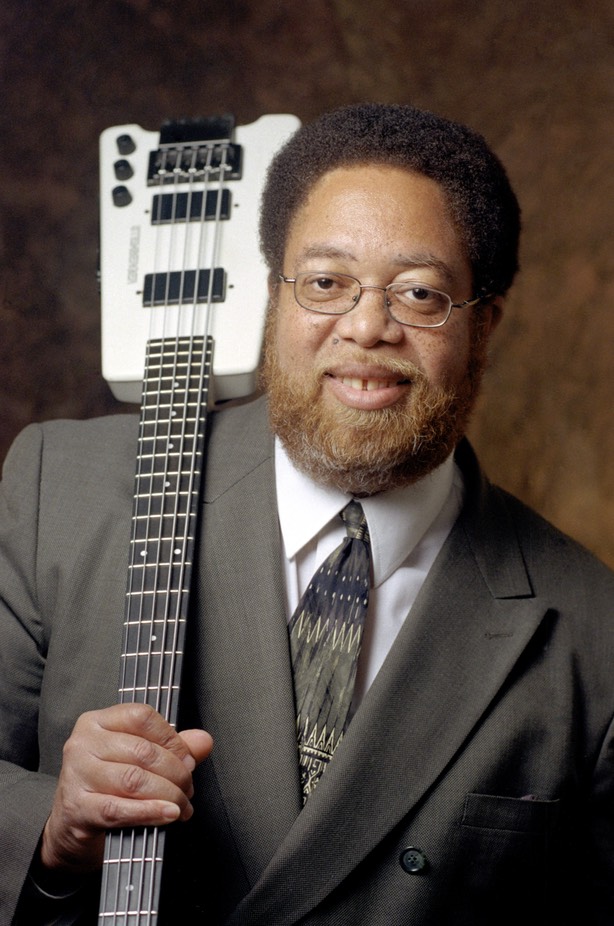
Hamilton's Department of Music presents a jazz appreciation month concert with “Doc” Woods on Wednesday, April 19, at 7:30 p.m., in Café Opus, Schambach Center for Music and the Performing Arts.
The concert, titled “Blowin’ in the Wind,” will consist of a suite of new charts written by Woods. In addition to local jazz musicians, Javon Jackson, saxophone, and Jakubu Griffin, drums, will be featured as guest artists.
This concert is free and open to the public. For more information call the box office at 859-4331 or visit www.hamilton.edu/performingarts.
